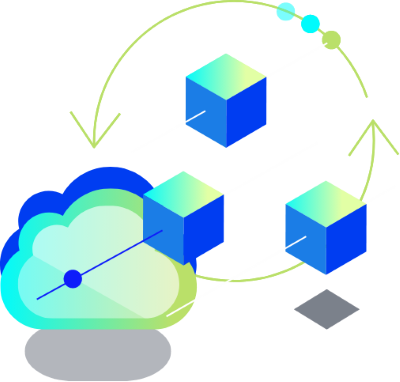What is Middleware?
Middleware acts as a versatile bridge in software development, connecting disparate applications and enabling seamless communication. It's the invisible glue that holds together complex systems, allowing different software components to interact and exchange info effortlessly.

Think of it as a translator, facilitating conversations between apps that speak different languages. Middleware encompasses a wide range of software and apps that operate behind the scenes, providing essential functionalities to apps.
It can handle tasks like data management, authentication, message queuing, and application integration. By abstracting these common services, middleware simplifies the development process and promotes reusability, ultimately saving time and resources.
Solutions encompass diverse types such as database, application server, message-oriented, web, and transaction-processing monitors. Each utilises messaging apps, enabling inter-application communication through frameworks like SOAP, web services, REST, or JSON.
The specific middleware chosen hinges on the service and information requirements, spanning security authentication, transaction management, message queues, servers, and directories. Notably, middleware facilitates real-time distributed processing, bypassing traditional info exchange delays.
What is Middleware architecture?
Middleware architecture refers to a system's structural design and organisation of middleware components. It outlines how different middleware services interact and collaborate to provide the necessary functionalities to apps.
Typically, middleware architecture follows a layered approach, where each layer provides specific apps and builds upon the capabilities of the underlying layers. A common middleware architecture consists of the following layers:
- Client layer: represents the user interface or the application that interacts with the middleware. It can be a web browser, a mobile app, or any other software that sends requests to and receives responses from the middleware.
- Presentation layer: is responsible for handling user interactions, formatting, and presentation logic. It receives requests from the client layer, processes them, and returns the appropriate response. This layer often includes components like web servers, application servers, and UI frameworks.
- Business logic layer: This layer contains the application's core business rules and processes. It performs calculations, validates data, makes decisions, and interacts with the access layer to retrieve and store information. This layer is often implemented using object-oriented programming languages and frameworks.
- Data access layer: provides access to databases and other data sources. It abstracts the underlying storage technology and provides a uniform interface for accessing and manipulating data. This layer often includes components like database drivers, object-relational mappers, and data caching mechanisms.
- Integration layer: facilitates communication and exchange between different applications and systems. It can handle various communication protocols, message formats, and transformations. This layer often includes components like message brokers, enterprise service buses, and API gateways.
- System layer: This layer interacts with the underlying operating system and hardware resources. It provides services like process management, memory management, file system access, and network communication. The operating system usually provides this layer or low-level libraries and drivers.
It’s complex, but the layered structure promotes modularity, maintainability, and scalability. It allows developers to modify or replace individual middleware components without affecting the entire system. Additionally, it enables the integration of new apps and technologies by adding or modifying specific layers.
What is middleware in cloud computing?
Middleware plays an important role in enabling the seamless integration and orchestration of various cloud apps and applications within cloud computing. It acts as a connective tissue, facilitating communication, exchange, and interoperability between different components within a cloud environment.
Cloud middleware typically encompasses a wide range of services and tools that address common challenges in cloud computing, such as:
- Scalability: Cloud middleware enables apps to scale up or down dynamically based on demand, ensuring optimal performance and resource utilisation.
- Reliability: It provides fault tolerance and high availability mechanisms to ensure continuous operation of cloud apps, even in the face of failures or disruptions.
- Security: Middleware enforces security policies and protocols to protect sensitive information and prevent unauthorised access to cloud resources.
- Integration: It enables seamless integration of cloud apps with on-premises systems and other cloud services, allowing for a hybrid cloud environment.
- Management: Finally, middleware provides tools and interfaces for monitoring, managing, and troubleshooting cloud and infrastructure.
By leveraging cloud middleware, organisations can accelerate their cloud adoption journey, reduce operational complexity, and unlock the full potential of cloud computing. It empowers developers to build and deploy cloud-native apps that are scalable, reliable, secure, and adaptable to changing business needs.
How Does Middleware Work?
Middleware operates as a versatile intermediary, facilitating seamless communication and data exchange between different applications, systems, and components. It acts as a bridge, abstracting the underlying complexities of communication protocols, formats, and platforms.
At its core, middleware provides a standardised interface that allows apps to interact with each other without needing to know the specifics of how each application works. This abstraction simplifies the development process and promotes interoperability, as applications can be built and deployed independently yet still communicate effectively.
The specific mechanisms by which middleware works can vary depending on the type of middleware and the specific use case. However, some common principles apply across different types of middleware:
- Message passing: Middleware often relies on message passing to enable communication between applications. Messages are self-contained data units exchanged between apps through a communication channel. Middleware can provide various message delivery guarantees, such as reliability, ordering, and persistence.
- Data transformation: Middleware can perform data transformations to ensure that data exchanged between applications is in a compatible format. This may involve converting data between different formats, filtering or aggregating data, or enriching data with additional information.
- Routing and orchestration: It can route messages between different applications based on predefined rules or business logic. It can also orchestrate complex workflows by coordinating the execution of multiple apps or services.
- Service discovery and invocation: Finally, middleware acts as a registry of available services and enables apps to dynamically discover and invoke these services. This allows for loose coupling between applications and promotes flexibility and scalability.
By providing these core functionalities, middleware enables applications to work together seamlessly, even if they are built using different technologies or run on different platforms. It simplifies the development process, improves application scalability and maintainability, and promotes interoperability between different systems.
Why middleware is important?
Middleware matters in modern software development and system integration, offering a multitude of benefits that streamline development processes, enhance system capabilities, and drive innovation. Its importance stems from the following key factors:
- Simplifying development: Middleware abstracts complex low-level details, allowing developers to focus on their apps' core business logic. It provides reusable components and services that handle common tasks such as communication, data management, and security, reducing the need to reinvent the wheel and accelerating development cycles.
- Enabling interoperability: This software layer also acts as a universal translator, facilitating communication and exchange between disparate applications, systems, and platforms. It bridges the gaps between different technologies, protocols, and formats, enabling seamless integration and collaboration.
- Enhancing scalability: It’s also true that you get scalability mechanisms that allow apps to dynamically adapt to changing workloads and demands. It enables load balancing, clustering, and failover capabilities, ensuring high availability, performance, and resilience.
- Promoting reusability: Middleware components and services are designed to be reusable across different apps and projects. This reusability saves time and effort and promotes consistency, maintainability, and standardisation.
- Improving flexibility: It enables loose coupling between applications, allowing them to evolve independently without impacting the overall system. It also provides flexibility in choosing technologies, platforms, and vendors, as applications can be easily integrated or replaced as needed.
- Enhancing security: Middleware can enforce security policies and protocols across the entire system, providing a centralised point of control for authentication, authorisation, and encryption. It helps protect sensitive data, prevent unauthorised access, and mitigate security risks.
Middleware helps reduce development and maintenance costs by simplifying development, enabling reusability, and promoting interoperability. It also optimises resource utilisation, leading to cost savings in infrastructure and operations.
All in all, middleware is a critical enabler of modern software development and system integration. Its versatility, scalability, and flexibility make it an indispensable tool for building complex, distributed, and heterogeneous systems.
Through leveraging middleware, organisations can streamline development processes, improve system capabilities, reduce costs, and drive innovation.
What is platform middleware?
Platform middleware is a comprehensive suite of software components designed to simplify application development, deployment, and management on a specific platform or operating system.
It acts as an intermediary layer between the application and the underlying platform, shielding developers from the platform's complexities and providing a consistent set of APIs and services.
Runtime Environments
Runtime environments are essential components of platform middleware, providing the necessary execution context for applications.
They offer features like memory management, garbage collection, and thread management, ensuring applications run smoothly and efficiently. Examples include Java Virtual Machine (JVMs) for Java applications, the .NET Common Language Runtime (CLR) for .NET applications, and Node.js runtime for JavaScript applications.
Application Servers
Application servers play a crucial role in hosting and managing web applications. They handle incoming requests from web browsers, process them using application code, and generate responses to be sent back to the client.
Application servers on web hosting also provide additional features like session management, security, and clustering for scalability and high availability.
Web Servers
Web servers are responsible for handling HTTP requests and responses and serving static and dynamic content to web browsers. They can handle various types of content, including HTML, CSS, JavaScript, images, and videos.
Web servers can also be extended with modules to provide additional functionality, such as SSL encryption, caching, and load balancing.
Messaging Systems
Messaging systems enable asynchronous communication between applications and components. They allow applications to exchange messages loosely coupled without requiring direct point-to-point connections.
Messaging systems often provide features like message queues, publish-subscribe patterns, and guaranteed delivery.
OVHcloud and Middleware
OVHcloud focuses on providing XaaS (everything as a service) infrastructure and platform services and offers solutions that can be utilised as part of a middleware architecture. These include:
Our cloud hosting infrastructure and platform services provide a solid foundation for building and deploying custom middleware solutions. Customers have the flexibility to choose the middleware components that best suit their needs and integrate them with OVHcloud's infrastructure.
Additionally, OVHcloud's focus on open standards and API connectivity allows for easy integration with a wide range of third-party middleware solutions. This gives customers the freedom to leverage their existing middleware investments or choose from a variety of best-of-breed solutions available in the market.



